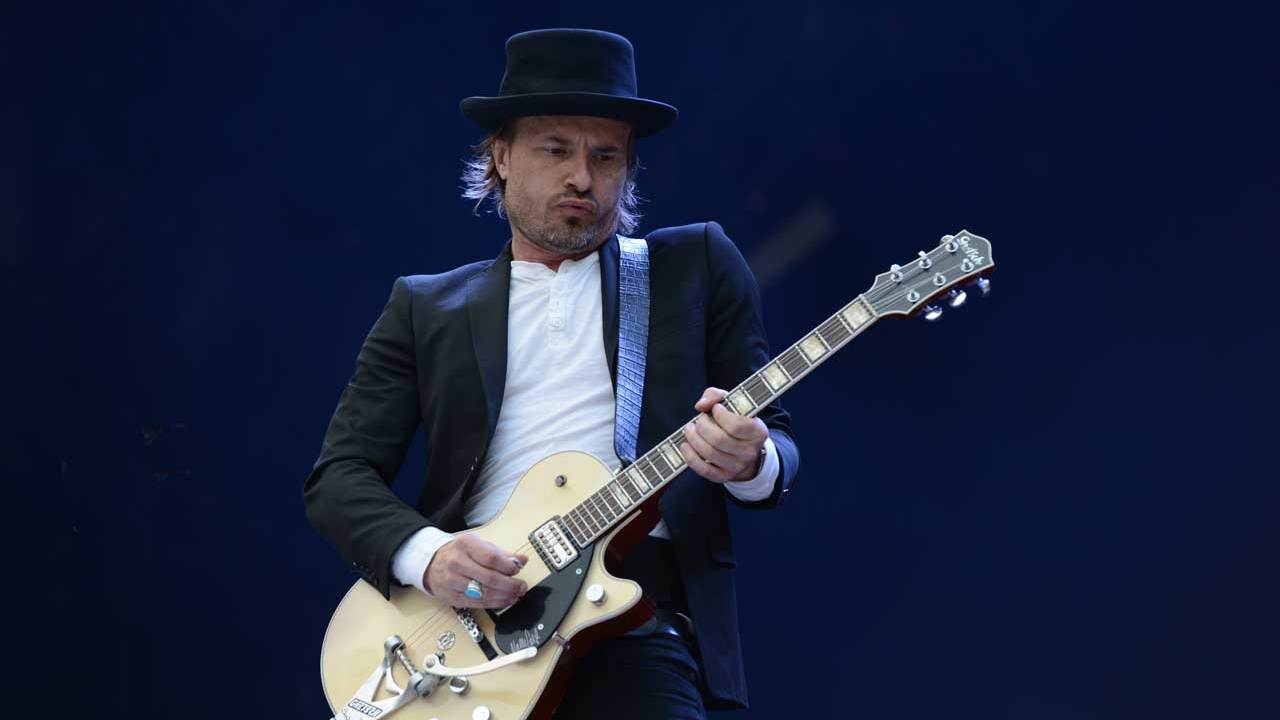Nalle Colt, guitarist for the red-hot blues-rock band Vintage Trouble, left his homeland of Sweden to pursue his musical dreams in America when he was 21. In fact, he was so sure of his convictions that he even bought himself a one-way ticket to Los Angeles. “That’s how badly I wanted to be part of the American scene,” he says. “I couldn’t get anything going in Sweden, but when I came to Los Angeles I discovered all of these people who were just like me. They wanted to be in a band and make something happen. I loved it.”
Growing up in Sweden, Colt found himself virtually alone in his love for the blues. There was one local guitarist, however, Jan-Eric ‘Fjellis’ Fjellstrom, who took the budding young axeman under his wing. “Fjellis was an amazing guitar player,” Colt raves. “I would go see him play and I couldn’t believe how good he was. He gave me a copy of Texas Flood and really helped expose me to a lot of great music. More than anybody, he inspired me to pursue the guitar.”
In compiling his choices for five essential guitar albums, Colt realized that they all share certain criteria, like great songs (“It can’t just be virtuoso guitar playing without the songs”), but also a level of communication through sound. “What I also look for is somebody who can use the tone of the guitar and turn it into something unique and personal,” he explains. “If you can show me a side to your personality through your sound, that’s key. It’s about conveying a feeling through your instrument, much like a singer does with his voice. Great guitarists know what that’s about.”
Colt also notes that the guitarists on his list, for the most part, speak a sophisticated language through an approach that is deceptively simple. “I love guitar players who can say more with less, which is harder than it seems,” he says. “The guitarists I tend to gravitate toward use their limitations to their advantage. I found out pretty early that I was never going to be a super-technical kind of player, but I decided that I was going use a couple of notes to get my point across.
“I listen to Hendrix and Page and Stevie Ray, and they could say everything they wanted with just one guitar part. It’s about purity in the message. You don’t need 20 overdubs and all kinds of crazy things; if you have one guitar saying what you want it to say, that’s enough. Find your weirdness and your joy and use it.”
Vintage Trouble’s new album, 1 Hopeful Rd., is available now.
The Jimi Hendrix Experience – Are You Experienced (1967)
“This is the album that made me want to play the guitar. I was 11 years old when I heard it, and it gave me the most insane goosebumps. I had to get a guitar. I had to try to do what Jimi was doing. There was no question about it – this record pointed the way.
“There was something about the way the guitar sounded in songs like Hey Joe and The Wind Cries Mary – it spoke to me in a way that I immediately understood. Hendrix could sound so cosmic but yet so earthy. It’s like he took the blues and send it into outer space. How somebody could play with such fire but then turn around and sound so beautiful? It just blew my mind.
“I sat for days and weeks near my turntable trying to learn the licks on this record. It became a constant pattern – on-off, flip the record over, start again. I was driving my mother crazy. I learned all the riffs. One thing that really struck me was how Jimi could play little melodies within guitar chords. Figuring that out was worth a year of guitar lessons. I use that type of technique today.”
Stevie Ray Vaughan and Double Trouble – Texas Flood (1983)
“Growing up in Sweden, it was hard for me to find cool music. One day a friend came over with a record, and he said, ‘You’ve got to hear this.’ It was Texas Flood. We put it, and I just looked at him like, ‘What the fuck? This guy is incredible!’ That kind of thing doesn’t happen all the time, but when it does it’s something special.
“It brought home everything I loved about Jimi Hendrix. Suddenly there was this young guy doing what Hendrix did and taking it one step beyond. After hearing Texas Flood, I nosedived into the world of Stevie Ray Vaughan. I bought every album and studied him completely. I wish I could have seen him live, although I have watched all the DVDs. His appearance on Austin City Limits was magical. Our band got to do the show a couple of weeks ago, and all I could think was, ‘Stevie was here.’”
Albert King – King of the Blues Guitar (1969)
“Now that I was such a Stevie Ray Vaughan fan, I read all of his interviews. He kept talking about his hero Albert King, so that made me go out and investigate him myself. I picked up King of the Blues Guitar and was knocked out. The attitude in the playing just came roaring out at me. It was totally out of control.
“I realized where Stevie Ray got everything from; he seemed to be a mix of Albert King and Jimi Hendrix. Once I got into Albert King, I started really putting it all together. The music was bold and raunchy. It came through with such confidence, and that made it so expressive. Nothing was held back – there was no filter between Albert and his pure, gutsy delivery.
“It’s always interesting when you hear the pioneers – you can’t spot their influences. They just seem to come at you with this ‘Fuck you. This is what I’m doing’ kind of attitude. If anybody wants to hear raw and original blues guitar, the guy who schooled so many greats, check out King of the Blues Guitar. It’s a trip.”
Led Zeppelin – The Song Remains the Same (1976)
“I love Physical Graffiti and Led Zeppelin II and all of their albums, but there’s something special about hearing Zeppelin live. They had a force all their own. They didn’t just perform; they exploded. To me, this was Jimmy Page at his best.
“What he could do with a Les Paul going into a Marshall. What tone! The Rain Song, Stairway to Heaven, Since I’ve Been Loving You – my God, talk about beautiful guitar playing. I love that it’s a little raunchy in places – you know, it’s live. So many bands can make good records, but they can’t cut it on stage. Zeppelin made incredible albums, but they could always bring it in concert.
“What I love is the spirit that comes through in Page’s playing. People talk about him being a little sloppy, and who cares, you know? I’m a little sloppy myself. I don’t need to hear perfection. I want to hear attitude and emotion, and that’s what I get from Page, especially live. Jimmy has become a big influence on me, more so now than ever before.”
Al Di Meola, John McLaughlin and Paco de Lucia – Friday Night in San Francisco (1981)
“I love the blues and rock‘n’roll, but this album speaks to me in a whole different way. When I was a kid, a friend gave me a copy of it, and it dazzled me immediately. It’s not the kind of guitar playing that I do, but I could appreciate each guy’s complete mastery of the instrument.
“Flamenco music has always intrigued me, and the fire and passion these guys bring to it is very inspiring. Their technique is out of control, but what I really love about it is the way they communicate with one another. They aren’t playing licks or doing tricks; they’re speaking to each other and to the audience.
“If you’re an electric guitar player, you might want to check out what these three guys can do on acoustics. Your jaw just might drop to the floor, as mine did. I’m still in awe of it. There’s music on here I still don’t really understand, but I feel it, and that’s what counts.”

